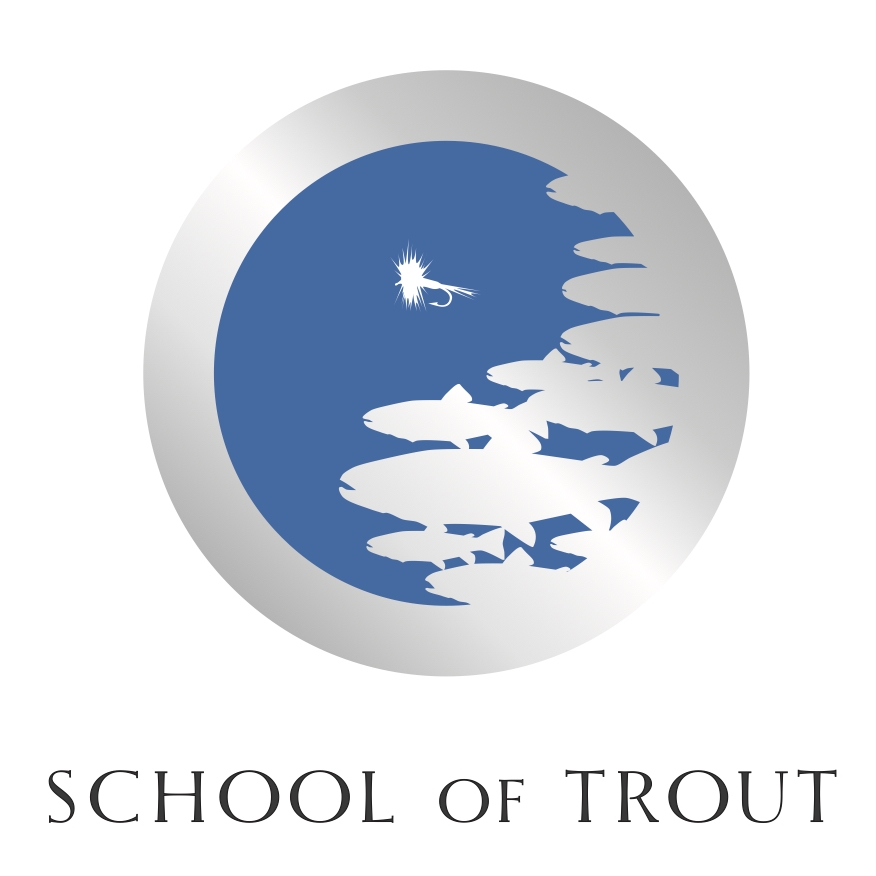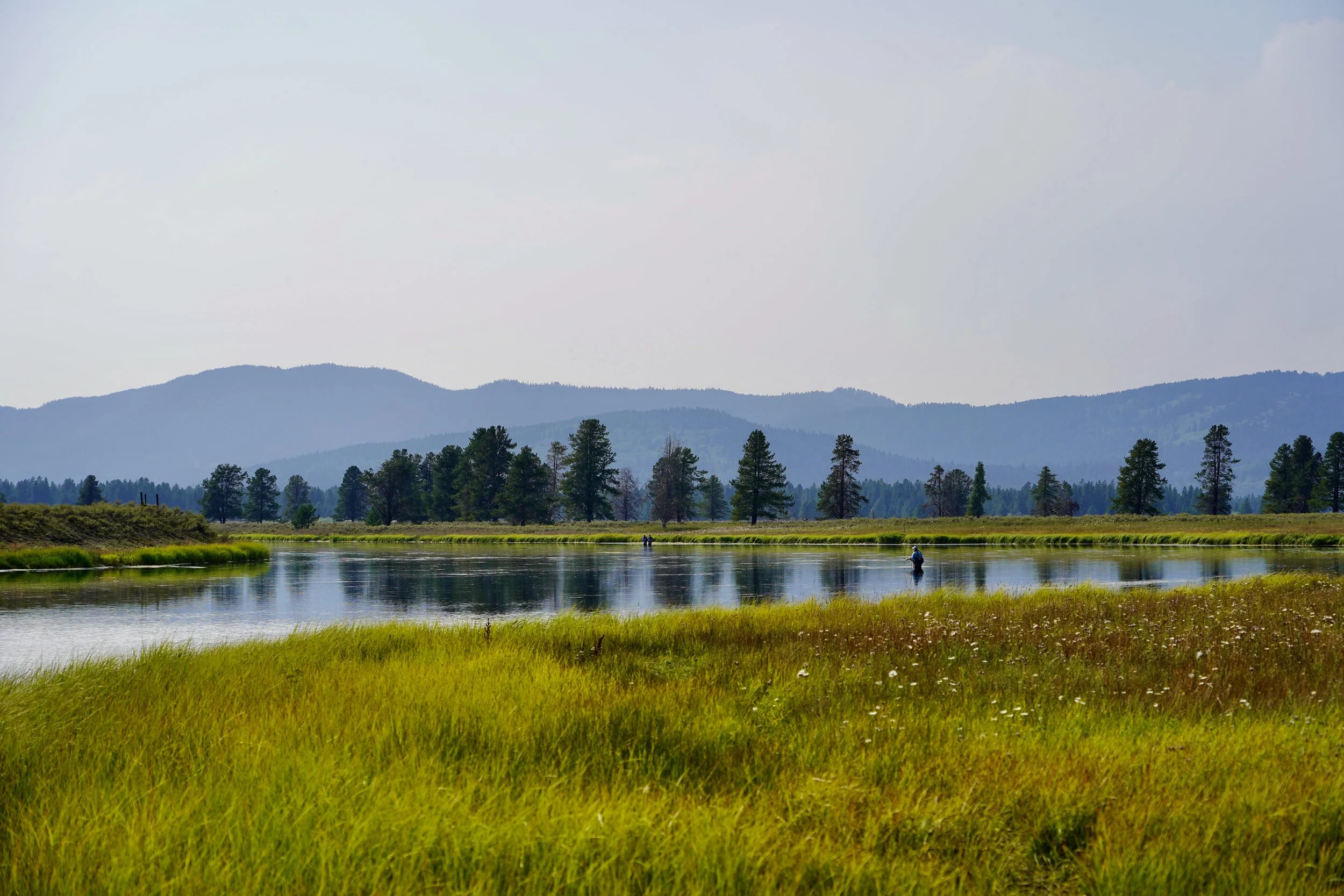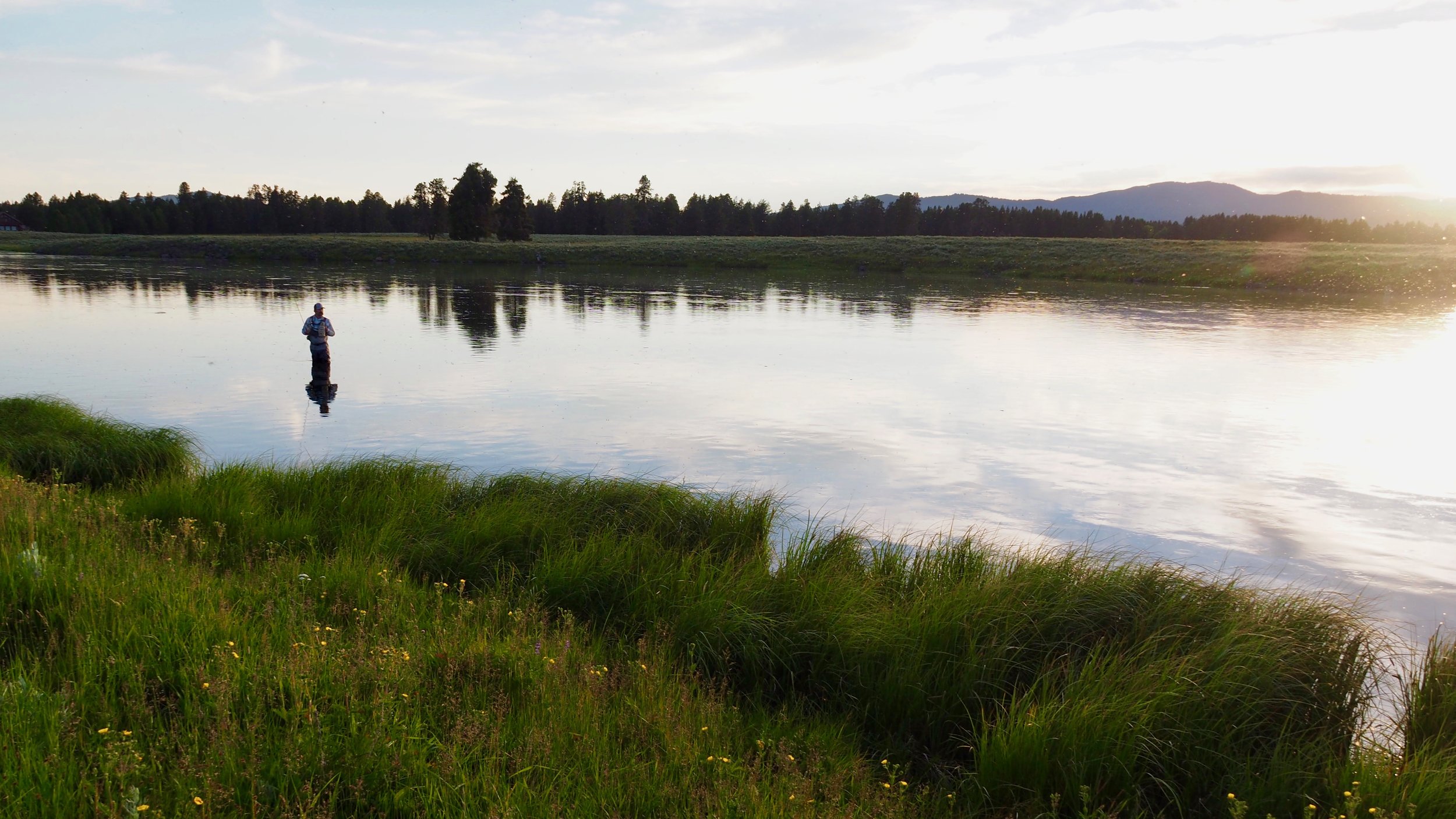Dry Fly Class Student Information
Here’s everything you need to know as you prepare for our September, 2025 Dry Fly class on the Henry’s Fork.
Location
Our 2025 Dry Fly class will be held at TroutHunter on the Henry’s Fork. TroutHunter is located in the small community of Last Chance, Idaho. The physical address is 3327 North U.S. Hwy 20, Island Park, Idaho 83429. The Henry’s Fork, one of the most famous trout fisheries in the world, flows right by the lodge. You’ll have a view of the river from your room.
For those who aren’t familiar with the area, Last Chance, Idaho is near the southwestern edge of Yellowstone National Park. It’s about 35 minutes (by car) from West Yellowstone, Montana, approximately 40 minutes from the Madison River near Slide Inn, Montana, and about 25 minutes from Ashton, Idaho. The Henry’s Fork is in the heart of the Rocky Mountains, with views of the Centennial Range and the Tetons.
Dates & Times
The class starts on Friday, September 12th and ends on Wednesday, September 17th. We suggest that students do their best to arrive between 3 pm and 4 pm on Friday the 12th. Registration runs from 3:00 pm to 5:00 pm. We’ll have a “meet & greet” hour from 5:30 pm to 6:30 pm. Dinner will be at 6:30 pm, and it will be followed by a short introduction to the class and our opening program.
We will wrap up the class at approximately 11am on Wednesday, September 17th.
Travel
We recommend that attendees fly into Idaho Falls, Idaho (IDA), then rent a car for the 1 hour and 15 minute drive to Last Chance. Your other options are to fly into Jackson Hole, Wyoming (JAC), which is a 2 hour and 15 minute drive, or Bozeman, Montana (BZN), a 2 hours and 30 minute drive, or Salt Lake City, Utah (SLC) which is 4 hours and 30 minutes.
If you’d prefer to take an airport shuttle from Idaho Falls, they are available via the Yellow Sally Shuttle Service.
Check In
When you arrive at TroutHunter, please walk into the fly shop, which is to the right of the main entrance, and tell the staff behind the counter that you’re there for the School of Trout. They’ll welcome you, give you your room assignment and hand you your room key. If you don’t already have an Idaho fishing license, they can set you up with one. (You can also purchase your license online if you prefer.)
Tab
During the check-in process, TroutHunter will open a tab in your name. TroutHunter has an excellent fly shop. You can put any purchases, as well as your fishing license and any gratuities for the TroutHunter staff, on your tab. If you do decide to run a tab, please remember to settle up before you leave.
Clothing
While it’s liable to be reasonably warm in September, it’s impossible to predict the exact weather or temperatures on the Henry’s Fork. We recommend that you pack for a wide variety of conditions, with the most likely conditions being cool mornings, warmer afternoons, and cool evenings. That means everything from light shirts and pants to rain gear and a warm jacket. We recommend that you consider clothing from reputable manufacturers like Patagonia and Orvis, and that you steer clear of cotton. Oh, and warm, high quality wool socks are a must for under your waders. (You’re welcome to wet wade, but please keep in mind that we do not recommend it.)
We also recommend that you opt for neutral colors when you’re on the water. With that in mind, try to steer clear of blacks, whites and bright-colored clothing. Better choices are light grays, tans, beiges, greens, olives, blues, etc.
If you have specific questions, or if you’d like our personal recommendations on appropriate clothing items, please drop us a note.
On the chance it might prove helpful, here’s a basic minimalist clothing list for the Henry’s Fork. (In general, it’s better to pack a little too heavy than a little too light, so consider the list below to be the minimum you should bring.)
Three lightweight shirts and three lightweight pairs of pants and/or shorts. (Synthetic rather than cotton.)
Underwear for your stay.
Three pairs of heavyweight wool socks.
Three pairs of lightweight wool or synthetic socks.
Two fishing shirts.
A lightweight synthetic hoody.
Fishing pants.
One light fleece pull-over.
One medium-weight fleece or puffy jacket.
One rain jacket designed to be worn over waders.
One fishing hat.
Comfortable, water-resistant shoes.
Sandals or warm weather footwear.
Fishing Gear
While we can help provide fly fishing gear for students who need it, we strongly recommend that you bring your own equipment. Ideally, you should arrive with:
A 9’, 4 weight or 5 weight fly rod (4 piece) with a matching reel and weight forward or double taper floating fly line. If you’d like to bring both a 4 weight rod and a 5 weight rod, that would be wonderful. (Please look below for a short discussion of fly rods & reels.) If you’re only going to bring one rod, a 5 weight is typically more versatile than a 4 weight.
Three 7.5’ 3X leaders
Three 9’ 4X leaders
Three 9’ 5X leaders
One spool of tippet material in the following sizes: 2X, 3X, 4X, 5X, 6X
Nippers
Forceps
Zinger
Magnifiers or reading glasses (if necessary)
A fly fishing vest or sling pack
Waders
Wading boots - studded
Polarized sunglasses
Fly Box
Floatant
Dessicant
Fly drying tube or patch
Net (optional)
A submersible digital thermometer for taking river temperatures
Gear bag or pack
Wading staff (optional)
Flies (Please bring your dry flies. We’ll also share a short list of appropriate flies below.)
There has been an awful lot written about fly rods, reels and lines over the years. Because fly rod preferences are so personal, it’s not always easy to suggest a particular rod or even a particular manufacturer to our students. In general, we ask that you bring a medium to medium-fast action 9’ 4-weight fly rod and/or a 9’ 5-weight fly rod, with a reel that balances the rod and a weight forward or double taper floating line. We’re not big fans of fast action and extra fast action rods; especially for dry flies.
Reputable rod manufacturers include Orvis, Winston, Sage, Redington, G.Loomis, Scott, Hardy, St. Croix, Montana Brothers, McFarland and T&T. Reputable reel manufactures include Nautilus, Abel, Ross, Orvis, Bauer, Galvan and Hatch. Reputable line manufacturers include Scientific Anglers, RIO, Cortland, Airflo and Orvis. Reputable leader and tippet manufacturers include TroutHunter, RIO, Orvis, Scientific Anglers and Umpqua.
If you’d like to discuss your tackle choices in detail, please drop us a note and we’ll schedule a phone call.
Flies
If you already have a selection of dry flies for trout, you should bring them with you. Your existing flies can help inform our discussions as we delve into fly choice and fly selection.
Mahogany Duns are the most important mid-September hatch on the Henry’s Fork. We may also see a few Callibaetis, a few caddis, and perhaps a few Gray Drakes. Terrestrials like beetles, ants, flying ants and grasshoppers can also be extremely important in September.
If you don’t have flies, or if you’d like to purchase additional flies to augment your current selection, we anticipate that some of the following choices could prove helpful at the class. Keep in mind that there are a number of incredibly effective mayfly patterns, including emergers, cripples, duns and spinners. Some of our favorites are the Last Chance Cripple (Harrop) and the Sparkle Dun (Mathews & Juracek).
Grasshoppers, sizes 8 - 12
Beetles, sizes 10 - 18
Ants, sizes 14 - 18
Flying ants, sizes 14 - 20
Mahogany Duns, sizes 16 & 18
Caddis, sizes 14 - 20
Gray Drake spinners, size 12 & 14
Rusty Spinners, sizes 16 & 18
Callibaetis Spinners, sizes 14 & 16
Adams, sizes 12 - 18
Parachute Adams, sizes 12 - 20
Royal Wulff, sizes 16 & 18
Fat Albert, sizes 6 - 12
Chubby Chernobyl, sizes 6 - 12
Royal Trude, sizes 10 - 14
Humpy, sizes 14 - 18
Stimulator, size 10 & 12
Madam X, sizes 8 & 10
In addition, TroutHunter typically has an excellent selection of flies for sale.
Finally, we will have a box of appropriate flies for you when you arrive at the class.
What Else To Bring
Waterproof camera or smart phone
Water bottle (We recommend insulated, stainless steel water bottles that will fit in your sling pack or fishing vest.)
Toiletry kit - toothbrush & toothpaste, shampoo, etc.
Sunscreen
Personal medical supplies, prescriptions, etc. (If you think you might need eye drops, lip balm, pain relievers, antacids, vitamins, etc., or if you want quick access to N-95 masks or Covid tests, please bring them with you.)
Notebook and pen
Ear plugs or noise-cancelling headphones (If you’re a light sleeper, it’s better to have them and not need them than to need them and not have them.)
Reading glasses (if necessary)
Snacks - If you have favorite snacks that you absolutely can’t do without, please bring them along or let us know well in advance so we can do our best to provide them.
A buff or neck gaiter to protect your neck and face from the sun.
Daily Schedule
You should anticipate full days at the School of Trout, with breakfast available from 7:00 to 8:30 am, and class starting at 9 am. Lunch will be at mid-day, and dinner will typically be from 6:30 to 7:30 pm. We’ll have something going on every night after dinner as well. You’re welcome to step away from class at any point if you need a little time for yourself, but keep in mind that we have a lot of information to share and we’ll be spending plenty of time on the water.
Food & Drink
We’ll be taking our meals as a group, so everyone — both students and instructors — will be eating together at TroutHunter.
Rather than a “please enjoy tonight’s lovely chicken dinner” approach, we’ll all be ordering off the TroutHunter menu. That way everyone gets exactly what they want, every meal, every day. TroutHunter’s menu is usually available on its website. If you have special requests, or if you have food allergies, please let us know as soon as possible so we can do our best to accommodate your needs.
We’ll have snacks and drinks available throughout the day. If you need or want something that you don’t see, please ask and we’ll do our best to accommodate you. If you have a particular snack that you simply can’t do without, either let us know ahead of time or bring a personal supply with you.
You can order a beer or a glass of wine with dinner, and that’s covered by your tuition. If you prefer something stronger, or if you want to have additional drinks after dinner, you can ask your server to put them on your TroutHunter tab and you can settle up when the class wraps up.
Personal Attention
If you arrive in Idaho and it turns out that you need extra help with any aspect of the class, please let us know right away and we’ll do everything we can to give you the personal support you need.
Tipping
There’s no need to tip the instructors at the School of Trout. We ask that you leave a generous gratuity for the TroutHunter staff who serve your meals, make your bed, clean your room, and work overtime to make sure you have a pleasant stay in Idaho.
Weather
Summers on the Henry’s Fork tend to be sunny and warm, but there are never any guarantees when it comes to the weather in the northern Rockies. Be sure to pack for a wide variety of conditions, and to have appropriate clothing for cool mornings or evenings.
Physical Activity
We’ll be doing some walking and wading, but we don’t anticipate anything too strenuous. The wading on the Henry’s Fork varies from location to location, but we’ll be spending most of our time in areas that are relatively easy to wade.
Relevant Personal Information
Please let us know if you have any physical conditions or special dietary requirements that we should be aware of before the class starts.
Covid-19
Covid-19 remains part of the national landscape. We recommend that everyone be up-to-date on their vaccinations, and that anyone traveling by airplane wears a N-95 or KN-95 mask on their flights to Montana.
TRIP INSURANCE
We are not insurance experts, and we do not recommend any specific plan or service, but trip insurance could potentially help you in the event of a problem or last-minute cancellation. From our perspective, trip insurance makes a ton of sense and we strongly suggest that you purchase it. (You can learn more here and here.)
Media & Photographers
There’s a chance that we will be taking photos and shooting video at times during the class, and we anticipate sharing some of the images with our students as a memento of our time in Idaho. We may also have members of the fly fishing media join us on occasion. If you’d prefer not to be photographed, or if you’d rather not interact with the occasional writer or videographer, that’s no problem at all. Just let us know ahead of time.



